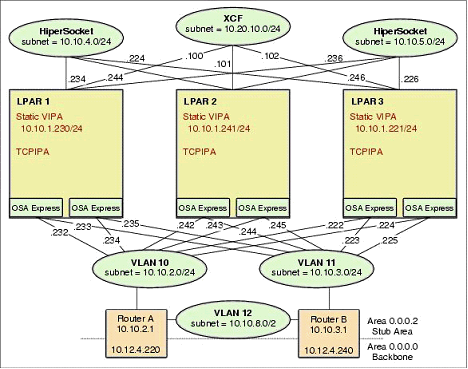Product Documentation
Abstract
This document describes an OSPF stub area, benefits of a stub area and steps for migrating from a traditional OSPF area design to a stub area design.
Content
An OSPF stub area is an area that does not permit flooding of AS external link state advertisements. It only receives routing information for destinations within the same stub area and for destinations in other areas within the OSPF domain. To reach destinations external to the OSPF domain, default routes (imported by the area border router) are used.
A stub area can reduce the amount of routing information that is received and processed in a z/OS environment. When OMPROUTE has less routing information to process, it will have smaller TCP/IP stack routing tables to manage. As a result, OMPROUTE's performance could improve as it would require less CPU cycles and storage.
When running multiple stacks in a Common INET (CINET) environment, each TCP/IP stack must provide OMVS with a copy of its current routing table. OMVS maintains a single routing table containing routing information from all of the TCP/IP stacks. When network topology changes occur, OMPROUTE on each TCP/IP stack must rebuild its routing table and ultimately OMVS must rebuild its routing table. Depending on the size of the network and the OSPF area design, OMVS may have a large routing table to build. As a result, OMVS could utilize large amounts of CPU, preventing other applications from obtaining necessary CPU cycles. Because OMPROUTE is a time sensitive application, it is important that OMPROUTE obtain sufficient CPU to prevent OSPF adjacency failures.
For these reasons, it is highly recommended that OMPROUTE be defined in an OSPF stub area or, even better, in a totally stubby area, which further limits the routing information received.
Before configuring an OSPF stub area, be aware of the following constraints:
- The backbone area (area 0.0.0.0) cannot be configured as a stub.
- Virtual links cannot be configured through stub areas.
- AS boundary routers, which advertise route information from external (non-OSPF) sources, cannot be placed internal to stub areas.
- There should be at least one area border router connecting the stub area to the rest of the network. If there are multiple such connections, they are redundant, so it does not matter which one is used to get outside the stub area.
The following are the basic steps to convert a traditional OSPF area into a stub area:
- 1. Configure OMPROUTE as stub area.
2. Configure network routers.
The following sections provide details for these basic steps.
1. Configure OMPROUTE as stub area.
In the OMPROUTE configuration file, define the non-backbone area as a stub area using the AREA statement.
The following is an example using non-backbone area 0.0.0.2:
- Area
Area_Number=0.0.0.2
Stub_Area=YES
Import_Summaries=YES;
All interfaces that are to belong to the stub area should be configured with an ATTACHES_TO_AREA statement.
The following example illustrates an OSPF interface being attached to the stub area 0.0.0.2:
- OSPF_Interface
IP_address=10.10.*.*
Subnet_mask=255.255.255.0
Cost0=4
MTU=1500
Attaches_To_Area=0.0.0.2;
2. Configure network routers.
The following is an example of a Cisco router being configured as an area border router.
- router ospf 100 (a)
router-id 10.10.2.1 (b)
log-adjacency-changes
area 2 stub (c)
network 10.10.0.0 0.0.255.255 area 2 (d)
network 10.200.1.0 0.0.0.255 area 0 (e)
The descriptions for the tags shown above are as follows:
(a) Designates the process 100 to be an OSPF routing service
(b) Defines the router ID of this process (100)
(c) Creates an OSPF area to this process (Area 2) and defines it to be a STUB Area.
(d) Defines the network range designated to Area 2.
All interfaces within this IP address range (10.10.0.0) will belong to Area 2.
(e) Defines the network range designated to the backbone Area 0.
All interfaces within this IP address range (10.200.0.0) will belong to Area 0.
Note: This is just an example, we recommend consulting with the appropriate router support for proper configuration.
D TCPIP,TCPIPA,OMP,OSPF,LIST,ALL
EZZ7831I GLOBAL CONFIGURATION 684
TRACE: 0, DEBUG: 0, SADEBUG LEVEL: 0
STACK AFFINITY: TCPIP
OSPF PROTOCOL: ENABLED
EXTERNAL COMPARISON: TYPE 2
AS BOUNDARY CAPABILITY: DISABLED
IMPORT EXTERNAL ROUTES: STA DIR SUB
ORIG. DEFAULT ROUTE: NO
DEMAND CIRCUITS: ENABLED
EZZ7832I AREA CONFIGURATION
AREA ID AUTYPE STUB? DEFAULT-COST IMPORT-SUMMARIES?
0.0.0.2 0=NONE YES 1 YES
0.0.0.0 0=NONE NO N/A N/A
EZZ7833I INTERFACE CONFIGURATION
IP ADDRESS AREA COST RTRNS TRDLY PRI HELLO DEAD DB_EX
10.20.10.100 0.0.0.2 4 5 1 1 10 40 40
10.10.3.2 0.0.0.2 10 5 1 0 10 40 40
10.10.5.236 0.0.0.2 100 5 1 1 10 40 40
10.10.4.235 0.0.0.2 100 5 1 1 10 40 40
10.10.4.234 0.0.0.2 100 5 1 1 10 40 40
10.10.3.235 0.0.0.2 10 5 1 0 10 40 40
DEMAND CIRCUIT PARAMETERS
IP ADDRESS DONOTAGE HELLO SUPPRESSION POLL INTERVAL
10.20.10.100 OFF N/A N/A
10.10.5.236 OFF N/A N/A
10.10.4.235 OFF N/A N/A
ADVERTISED VIPA ROUTES
10.10.1.230 /255.255.255.255
For further optimization, configure OSPF as a totally stubby area which receives less routing information than a stub area. It only knows of destinations within the stub area. The area border router will import default routes to be used for destinations in other OSPF areas and destinations external to the OSPF domain.
A totally stubby area is defined by specifying IMPORT_SUMMARIES=NO on the AREA statement.
For example:
- Area
Area_Number=0.0.0.2
Stub_Area=YES
Import_Summaries=NO;
Example of OSPF stub area design:

Was this topic helpful?
Document Information
Modified date:
17 June 2018
UID
swg27011674